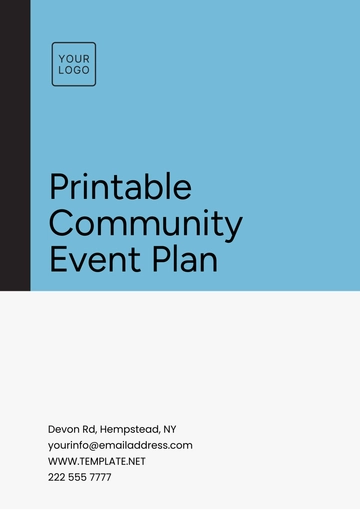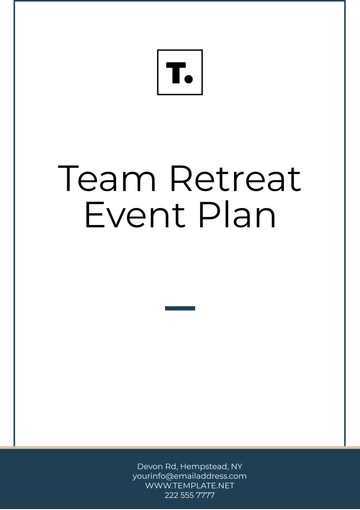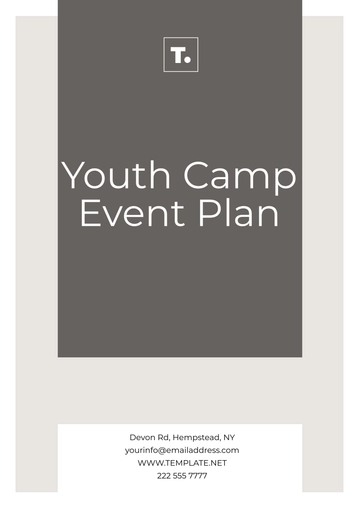Free Printable Community Event Plan

I. Introduction
Organizing a community event requires meticulous planning and execution to ensure success. This guide outlines essential steps to effectively plan and host a community event that engages participants, fosters community spirit, and creates lasting connections.
II. Objective of the Event
The primary objective of this community event is to unite residents, enhance community spirit, and provide a range of educational and recreational activities that cater to participants of all ages and backgrounds.
III. Planning
1. Determine Event Type and Theme
Event Type: Decide on the nature of the event—options may include a festival, workshop, picnic, charity fundraiser, or community fair.
Theme Selection: Choose a theme that resonates with the community's interests and values, enhancing relevance and appeal.
2. Set a Budget
Detailed Budgeting: Outline all potential expenses, including:
Venue rental
Equipment and supplies
Marketing and advertising
Permits and Insurance
Refreshments and catering
Contingency Fund: Allocate a contingency fund (typically 10-20% of the total budget) to cover unexpected costs.
3. Select a Date and Location
Date Selection: Choose a date that does not conflict with other local events or holidays to maximize attendance.
Location: Select a venue that is accessible to all community members, considering factors such as parking, public transport, and facilities.
4. Obtain Permits and Insurance
Permits: Secure all necessary permits in advance to comply with local regulations.
Insurance: Ensure adequate insurance coverage to address liabilities and potential damages during the event.
IV. Promotion and Marketing
1. Develop a Marketing Strategy
Flyers and Posters: Create eye-catching flyers and distribute them in community centers, schools, libraries, and local businesses.
Social Media Campaign: Utilize platforms such as Facebook, Instagram, and Twitter to promote the event and engage with the community.
Local Media: Collaborate with local radio stations, newspapers, and blogs to generate awareness and excitement about the event.
2. Encourage Community Involvement
Sponsorship Opportunities: Invite local businesses and organizations to sponsor the event, creating a sense of ownership and fostering community relationships.
Volunteer Recruitment: Encourage community members to volunteer, promoting engagement and inclusivity.
V. Logistics
1. Equipment and Supplies
Item | Quantity | Source |
|---|---|---|
Chairs | 100 | Local Rental Company |
Sound System | 1 | Community Center |
Tents | 5 | Event Supplier |
Tables | 20 | Local Rental Company |
Refreshments | TBD | Local Caterer |
2. Staffing and Volunteers
Volunteer Recruitment: Reach out to local schools, organizations, and community groups to recruit volunteers.
Roles and Responsibilities: Assign roles and responsibilities, providing detailed descriptions to ensure effective communication and execution.
VI. Execution
1. Setup and Event Management
Setup Coordination: Ensure all equipment and supplies are set up before the event begins. Designate points of contact for each event area to streamline communication and address issues as they arise.
Schedule: Create a detailed schedule for the event day, outlining timelines for activities and key responsibilities.
2. Safety and Emergency Protocols
Safety Plan: Develop a comprehensive safety plan that includes first aid provisions, emergency contact information, and evacuation routes.
Staff Briefing: Brief all staff and volunteers on safety protocols, emergency procedures, and their specific roles to ensure readiness.
VII. Post-Event Evaluation
1. Gather Feedback
Feedback Collection: Distribute surveys and feedback forms to attendees, volunteers, and collaborators to gather insights on their experiences.
Incentives: Consider offering small incentives for completing feedback forms to encourage participation.
2. Review and Analyze Data
Attendance Analysis: Evaluate attendance numbers and participant demographics to assess engagement levels.
Budget Review: Analyze budget adherence and financial outcomes to identify successes and areas for improvement.
3. Documentation and Reporting
Comprehensive Report: Compile a detailed report summarizing the event's successes, challenges, and lessons learned.
Stakeholder Communication: Share the report with stakeholders, sponsors, and volunteers to maintain transparency and build relationships for future events.
- 100% Customizable, free editor
- Access 1 Million+ Templates, photo’s & graphics
- Download or share as a template
- Click and replace photos, graphics, text, backgrounds
- Resize, crop, AI write & more
- Access advanced editor
Plan your next community event effortlessly with the Printable Community Event Plan Template from Template.net. This fully customizable template is designed to streamline your planning process. Easily editable in our AI Editor Tool, it allows you to tailor every detail to fit your unique needs, ensuring a successful and engaging event for everyone involved.
You may also like
- Finance Plan
- Construction Plan
- Sales Plan
- Development Plan
- Career Plan
- Budget Plan
- HR Plan
- Education Plan
- Transition Plan
- Work Plan
- Training Plan
- Communication Plan
- Operation Plan
- Health And Safety Plan
- Strategy Plan
- Professional Development Plan
- Advertising Plan
- Risk Management Plan
- Restaurant Plan
- School Plan
- Nursing Home Patient Care Plan
- Nursing Care Plan
- Plan Event
- Startup Plan
- Social Media Plan
- Staffing Plan
- Annual Plan
- Content Plan
- Payment Plan
- Implementation Plan
- Hotel Plan
- Workout Plan
- Accounting Plan
- Campaign Plan
- Essay Plan
- 30 60 90 Day Plan
- Research Plan
- Recruitment Plan
- 90 Day Plan
- Quarterly Plan
- Emergency Plan
- 5 Year Plan
- Gym Plan
- Personal Plan
- IT and Software Plan
- Treatment Plan
- Real Estate Plan
- Law Firm Plan
- Healthcare Plan
- Improvement Plan
- Media Plan
- 5 Year Business Plan
- Learning Plan
- Marketing Campaign Plan
- Travel Agency Plan
- Cleaning Services Plan
- Interior Design Plan
- Performance Plan
- PR Plan
- Birth Plan
- Life Plan
- SEO Plan
- Disaster Recovery Plan
- Continuity Plan
- Launch Plan
- Legal Plan
- Behavior Plan
- Performance Improvement Plan
- Salon Plan
- Security Plan
- Security Management Plan
- Employee Development Plan
- Quality Plan
- Service Improvement Plan
- Growth Plan
- Incident Response Plan
- Basketball Plan
- Emergency Action Plan
- Product Launch Plan
- Spa Plan
- Employee Training Plan
- Data Analysis Plan
- Employee Action Plan
- Territory Plan
- Audit Plan
- Classroom Plan
- Activity Plan
- Parenting Plan
- Care Plan
- Project Execution Plan
- Exercise Plan
- Internship Plan
- Software Development Plan
- Continuous Improvement Plan
- Leave Plan
- 90 Day Sales Plan
- Advertising Agency Plan
- Employee Transition Plan
- Smart Action Plan
- Workplace Safety Plan
- Behavior Change Plan
- Contingency Plan
- Continuity of Operations Plan
- Health Plan
- Quality Control Plan
- Self Plan
- Sports Development Plan
- Change Management Plan
- Ecommerce Plan
- Personal Financial Plan
- Process Improvement Plan
- 30-60-90 Day Sales Plan
- Crisis Management Plan
- Engagement Plan
- Execution Plan
- Pandemic Plan
- Quality Assurance Plan
- Service Continuity Plan
- Agile Project Plan
- Fundraising Plan
- Job Transition Plan
- Asset Maintenance Plan
- Maintenance Plan
- Software Test Plan
- Staff Training and Development Plan
- 3 Year Plan
- Brand Activation Plan
- Release Plan
- Resource Plan
- Risk Mitigation Plan
- Teacher Plan
- 30 60 90 Day Plan for New Manager
- Food Safety Plan
- Food Truck Plan
- Hiring Plan
- Quality Management Plan
- Wellness Plan
- Behavior Intervention Plan
- Bonus Plan
- Investment Plan
- Maternity Leave Plan
- Pandemic Response Plan
- Succession Planning
- Coaching Plan
- Configuration Management Plan
- Remote Work Plan
- Self Care Plan
- Teaching Plan
- 100-Day Plan
- HACCP Plan
- Student Plan
- Sustainability Plan
- 30 60 90 Day Plan for Interview
- Access Plan
- Site Specific Safety Plan





























